 |
| July 28, 2020 | Volume 16 Issue 28 |
Designfax weekly eMagazine
Archives
Partners
Manufacturing Center
Product Spotlight
Modern Applications News
Metalworking Ideas For
Today's Job Shops
Tooling and Production
Strategies for large
metalworking plants
Defiant attack helicopter proves it's faster than Black Hawk
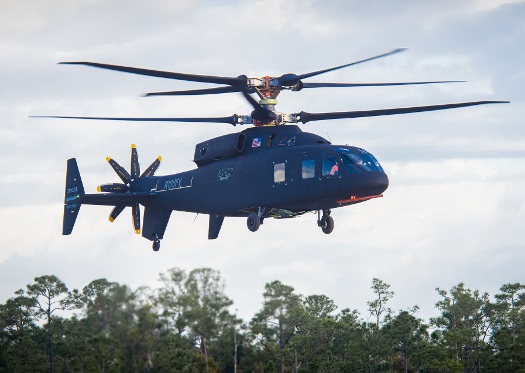
SB-1 Defiant demonstrator, a Sikorsky-Boeing contender in the U.S. Army's Future Long-Range Assault Aircraft (FLRAA) program.
On a recent flight test, Sikorsky-Boeing's new SB-1 Defiant attack and assault helicopter demonstrator proved it was faster than the long-in-service Black Hawk by reaching 205 knots (236 mph) -- and Defiant is designed to go much faster. The new medium-lift, compound coaxial copter completed its first flight back in March 2019. The Black Hawk's top speed is 193 knots (222 mph).
Sikorsky Chief Test Pilot Bill Fell said this milestone is just the beginning and the SB-1 has "got a lot more in it."
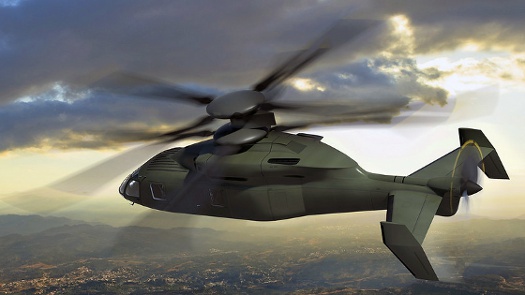
SB-1 Defiant initial prototype illustration.
With its two coaxial main rotors and rear-mounted, all-electric pusher propulsor, the single-engine Defiant is unlike production rotorcraft available today. It represents what its designers think is a leap forward in technology to achieve the U.S. government's desire for vast increases in speed and range, while improving maneuverability and survivability in a cost-effective way.
"Defiant is designed to fly at nearly twice the speed and has twice the range of conventional helicopters while retaining the very best, if not better low-speed and hover performance of conventional helicopters," said Dan Spoor, vice president, Sikorsky Future Vertical Lift. "This design provides for exceptional performance in the objective area, where potential enemy activity places a premium on maneuverability, survivability, and flexibility."
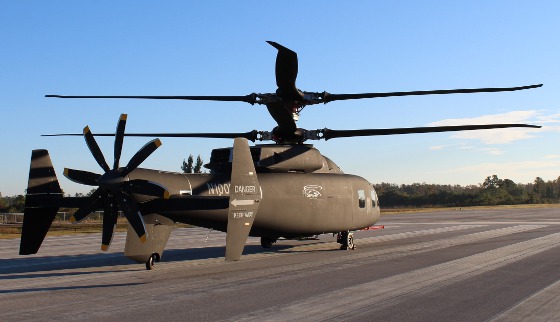
SB-1 Defiant demonstrator rear view.
The U.S. Army has a stated goal to replace the UH-60 Black Hawk helicopter in fiscal year 2030. The SB-1 Defiant is one of two designs being considered as replacements in the Future Long-Range Assault Aircraft (FLRAA) program as part of the Army's Future Vertical Lift (FVL) initiative, the Army's No. 3 modernization priority area.
The winning design will be required to blend airplane-like speeds with helicopter-like maneuverability. The aircraft will need to maintain 100 percent maximum continuous power, medical evacuation capabilities, and (per guidelines) have the ability to perform a 500-ft-per-min. vertical rate of climb. It will have to soar at 6,000 ft in 95-degree heat, with up to 12 passengers and for roughly 1,725 nautical miles one way without refueling. The program's objective cruise speed is 280 knots, or roughly 320 mph.
Bell Textron's part-aircraft, part-helicopter design called the Bell V-280 Valor is the other contender. So far, Valor, which sports two transformational tiltrotors, has flown at speeds around 200 knots (230 mph) in testing. It includes a fly-by-wire flight control system.
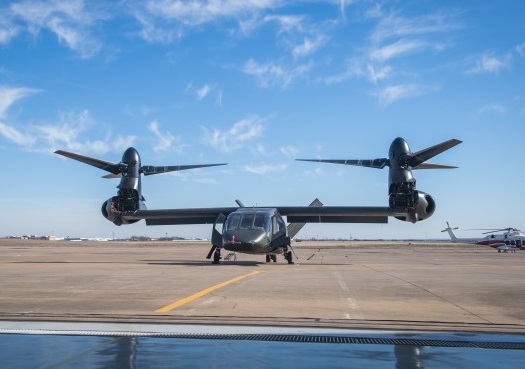
The Bell V-280 Valor tiltrotor aircraft is one of two contenders in the Army's competition to replace the UH-60 Black Hawk. [Photo Credit: U.S. Army, Sgt. Dana Clarke]
Both helicopters are participating in the Army's Joint Multi-Role-Medium Technology Demonstrator program. Neither one of the current demonstrator vehicles is considered the ultimate final design, should it be chosen.
The Sikorsky-Boeing SB-1 Defiant is counting on its X2 Technology (counter-rotating blade) design to make it the U.S. Army's top choice due to its scalability to a variety of military missions such as attack and assault, long-range transportation, infiltration, and resupply. X2 was first developed on Sikorsky's two-seater XH-59A prototype, which made significant improvements in vibration reduction, weight reduction, and blade technology. It boasts improved hover performance, rapid maneuverability, and crisp control response due to the rigid rotor -- all while maintaining helicopter-like performance at low speeds.
The SB-1 Defiant can hold a crew of four. It has fly-by-wire flight controls, manually foldable blades to reduce space requirements during parking, a composite fuselage, and retractable landing gear.
According to a Feb. 26, 2020, article on Business Insider by Matthew Cox of Military.com, "Test pilots on Defiant said they love the [electric] rear pusher prop, which is designed to provide revolutionary thrust, but are also comforted that it can take direct hits in combat without causing catastrophic failure to the aircraft."
The article also says, "The pusher prop can also be reversed very quickly to provide negative thrust for quick braking power, and then turned off for a quieter sound signature."
VIDEO: On June 9th, 2020, the SB-1 Defiant expanded its flight envelope, achieving 205 knots during testing and surpassing the top speed of the Black Hawk helicopter. Reaching new speeds in low-level flight will be key to providing the U.S. Army the capabilities needed to dominate the multidomain battlefields of the future.
The X2 Technology is also used in the smaller Sikorsky S-97 RAIDER demonstrator, a high-speed scout and attack compound copter that has already proven a maximum cruise speed of 253 knots (291 mph). Test pilot Fell said back in 2019 that the low- and high-speed maneuverability of an X2 Technology flyer -- which can fly at as much as 60-plus degrees of bank -- and the ability to hover in high altitudes and hot conditions "make a helicopter fly more like a tactical jet aircraft than a classic rotorcraft."
VIDEO: Pilots' Perspective: Flying the Sikorsky-Boeing SB-1 Defiant.
The U.S. Army has stated no official date for the downselect of the final, winning design, but fiscal year 2022 has been mentioned in several reports as the soft target. The technological readiness of both designs as well as evolving military budgets will influence the final selection timeline.
----------------------
UPDATE: July 23, 2020
Army searches for improved mission systems in future aircraft
By Devon Suits, U.S. Army
The Army is exploring improved mission systems configurations for both the Future Long-Range Assault Aircraft (FLRAA) and Future Attack Reconnaissance Aircraft (FARA), as project officials engaged with industry in a collaborative market research effort this summer.
This year, project managers launched a Mission Systems Optimization Study to evaluate hardware and software solutions to better inform near-term decisions for both aircraft, said Col. Gregory Fortier, FARA lead with Program Executive Office-Aviation.
"We took a recent [request for information] with industry with over 300-plus technologies and combined that with previous RFIs from the FLRAA team," Fortier said July 9 during the virtual International Military Helicopter USA conference.
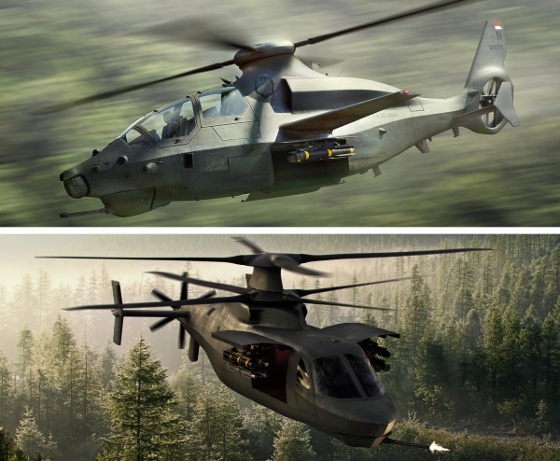
The prototype designs being considered for the Future Attack Reconnaissance Aircraft (FARA) are the Bell 360 Invictus (top) and the Sikorsky Raider-X (bottom). [Photo illustrations courtesy of Bell Helicopter Textron Inc. and Sikorsky Aircraft Corp.]
Through the RFIs, project managers sought to identify "commonalities" to improve both aircraft's sustainability and help mitigate overall costs, Fortier said. Officials then used the compiled RFIs to discuss qualified mission system capabilities.
FARA and FLRAA officials will now work together to develop a series of recommendations in November, Fortier said. Project managers are working hard to avoid "stovepiping" each project as they continue through this analysis process.
The footprints of each aircraft are significantly different, Fortier explained. For example, the FARA has a requirement to reach a speed close to 210 mph, while FLRAA's engineering will allow it to reach potential speeds above 290 mph.
"There will be some components along the way that we will have to look at in terms of unique mission systems," Fortier said. "That dialogue has already started to happen ... and will be refined over time."
The Army is scheduled to reach a final design decision for FARA by December, Fortier added. The force will then proceed to the competitive prototyping phase, as it looks to build a combat-ready system by fiscal year 2030.
"We understand that affordability is absolutely paramount to these programs," Fortier said. "We spend every single day ... [discussing] both the FLRAA and FARA timeline so that we can get both aircraft to the finish line."
Mission system domains
Through the optimization study, project officials have targeted eight focus areas, or domains, necessary to improve each aircraft. These fields include: communications, navigation, sensors, effector or weapons, survivability, architecture or digital backbone, pilot interface, and data fusion.
In terms of mission system planning, "we have written the requirements ... to allow for flexibility," said Brig. Gen. Walter Rugen, the Future Vertical Lift Cross-Functional Team director. "If the next generation of capabilities is not ready, then we can use the current technology. Project managers are in charge of teeing up those decisions for the aviation enterprise."
Fortier said the eight domains are intended to discover "what is in the realm of the possible" and how new technology will fit into the Army's future aircraft. And while there currently is no rank order to the eight domains, both project managers have emphasized the need for a modular open systems approach, or MOSA.
Formerly known as an open systems architecture, MOSA is a strategy designed to create and implement affordable and adaptable technologies through a widely supported systems interface or architecture, according to the Department of Defense standardization program.
Proper integration of MOSA in both aircraft combined with an appropriate digital backbone that can support rapid aircraft survivability or other technological upgrades is absolutely critical, Fortier said.
"There are some innovative folks out there that understand the direction we are going," said Col. David Phillips, FLRAA project manager. "We are taking their feedback, and we see that as opportunities to bring in that 'best of breed' system when it's ready, as opposed to a long development or integration cycle that can be costly, and put us behind."
Sources: Sikorsky, Lockheed Martin, Bell Helicopter, U.S. Army
Published June/July 2020
Rate this article
View our terms of use and privacy policy
